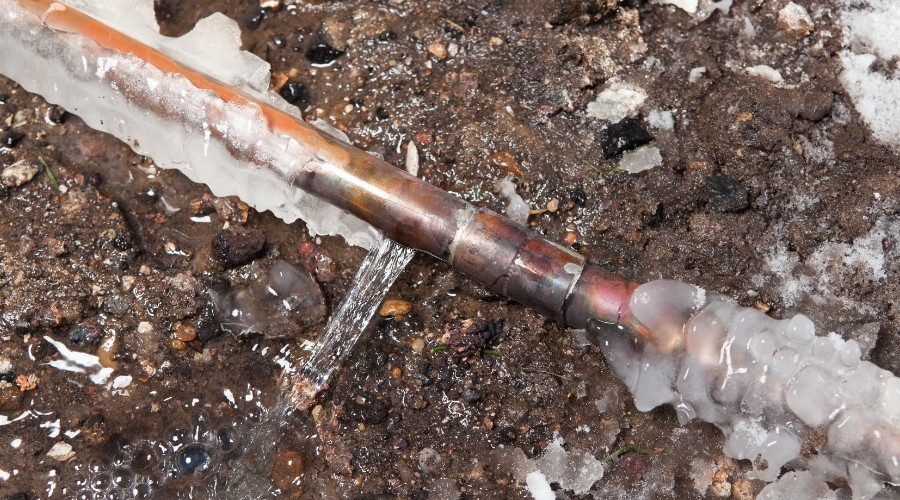How to Prevent Frozen Pipes This Winter
When temperatures plunge, plumbing systems face serious stress, especially in unheated or poorly insulated areas of a building. Frozen pipes can quickly lead to a pipe burst, causing extensive water damage, costly water leak repairs, and major disruption. This post explains practical ways to protect the plumbing system during colder temperatures, including how to insulate vulnerable pipes, use indoor heat strategically, and properly winterize every outdoor faucet.
Insulate the Pipes
 One of the most effective defenses against frozen pipes is adding pipe insulation to exposed lines. Pipes that run through unconditioned spaces—such as attics, crawl spaces, unfinished basements, or garages—are especially vulnerable because these areas tend to stay much colder than the living space. When water inside these pipes freezes, it expands and can create enough pressure to cause a pipe burst, often before anyone realizes there is a problem.
One of the most effective defenses against frozen pipes is adding pipe insulation to exposed lines. Pipes that run through unconditioned spaces—such as attics, crawl spaces, unfinished basements, or garages—are especially vulnerable because these areas tend to stay much colder than the living space. When water inside these pipes freezes, it expands and can create enough pressure to cause a pipe burst, often before anyone realizes there is a problem.
Installing pipe insulation creates a protective barrier that slows heat loss from the water inside. Foam sleeves, fiberglass wraps, or specialized insulating tape can be used to insulate pipes of different diameters and materials. Extra attention should be given to plumbing located along exterior walls or near vents, windows, and doors where cold air can easily reach water lines. Taking the time to insulate pipes that have frozen in previous winters is especially important, as these sections are proven weak spots.
Beyond preventing freezing pipes, pipe insulation offers additional benefits. Insulated hot water lines generally keep water warmer over longer distances, reducing wait time at faucets and showers. For older homes or properties in harsh winter climates, a focused effort to insulate pipes in vulnerable locations is a smart, preventive investment that helps reduce the risk of an unexpected burst pipe.
Keep the Heat on and Open Cabinets
 Indoor heating provides a crucial layer of protection for plumbing during winter. Keeping the heating system running and setting the thermostat to a consistent temperature helps maintain warmer air throughout the building, including in corners and rooms that tend to feel cooler. Large temperature swings—such as turning the heat down dramatically at night or when the home is unoccupied—can raise the risk of freezing pipes in these marginal areas.
Indoor heating provides a crucial layer of protection for plumbing during winter. Keeping the heating system running and setting the thermostat to a consistent temperature helps maintain warmer air throughout the building, including in corners and rooms that tend to feel cooler. Large temperature swings—such as turning the heat down dramatically at night or when the home is unoccupied—can raise the risk of freezing pipes in these marginal areas.
Opening cabinet doors that conceal plumbing is another simple yet powerful strategy. Cabinets under kitchen and bathroom sinks often enclose pipes that sit against exterior walls. When cabinet doors remain closed, cold air can become trapped inside, allowing temperatures around the pipes to drop faster. Leaving these doors open allows warm indoor air to circulate more freely around the plumbing, helping to keep water inside from reaching freezing temperatures.
Combining steady indoor heat with open cabinets and existing pipe insulation creates multiple layers of defense against frozen pipes. When this approach is paired with regular heating system maintenance to keep equipment functioning reliably, the likelihood of a cold snap causing a pipe burst or major water damage drops significantly.
Winterize Outdoor Faucets
Outdoor plumbing fixtures are among the first components to freeze once winter weather sets in, making proper preparation of each outdoor faucet essential. The winterization process begins with removing any attached hoses, splitters, or accessories. Garden hoses should be completely drained and stored indoors, since water trapped inside can freeze, expand, and push damaging pressure back into connected pipes.
Next, the shut-off valve controlling the water supply to each outdoor faucet—typically located inside the building—should be turned off, if one is available. After closing the supply, open the outdoor faucet to allow any remaining water in the line to drain completely. Leaving the valve slightly open after draining provides space for any tiny amount of residual water to expand without cracking the pipe.
For added protection, an insulating cover can be installed over every outdoor faucet. These covers help shield fixtures from direct exposure to wind and frigid air, further reducing the risk of freezing. When hoses are disconnected and drained, supply valves closed, lines emptied, and each outdoor faucet covered, plumbing connected to exterior walls is far better protected against winter conditions that can otherwise lead to a pipe burst.
By insulating vulnerable pipes, keeping indoor temperatures steady, opening cabinets, and thoroughly winterizing outdoor fixtures, households can significantly reduce the risk of frozen pipes, leaks, and costly cold-weather plumbing damage.
About Postma Heating & Cooling
Postma Heating & Cooling is a highly-rated plumbing, heating, cooling, and electrical company proudly serving the communities of Chatham-Kent with straightforward pricing and a satisfaction guarantee. Call them today for same-day service and flat-rate pricing on burst pipe repair in Chatham-Kent, ON.



